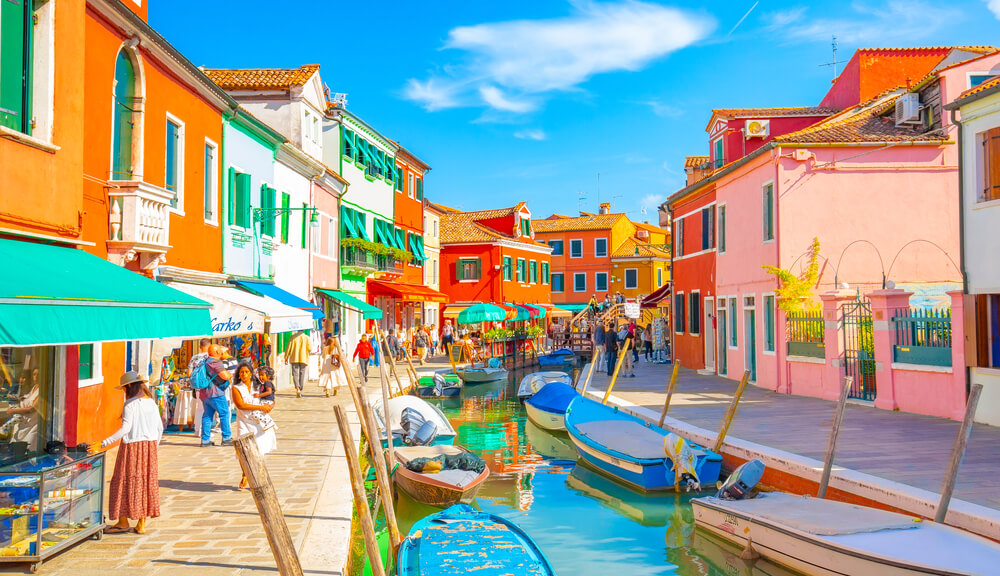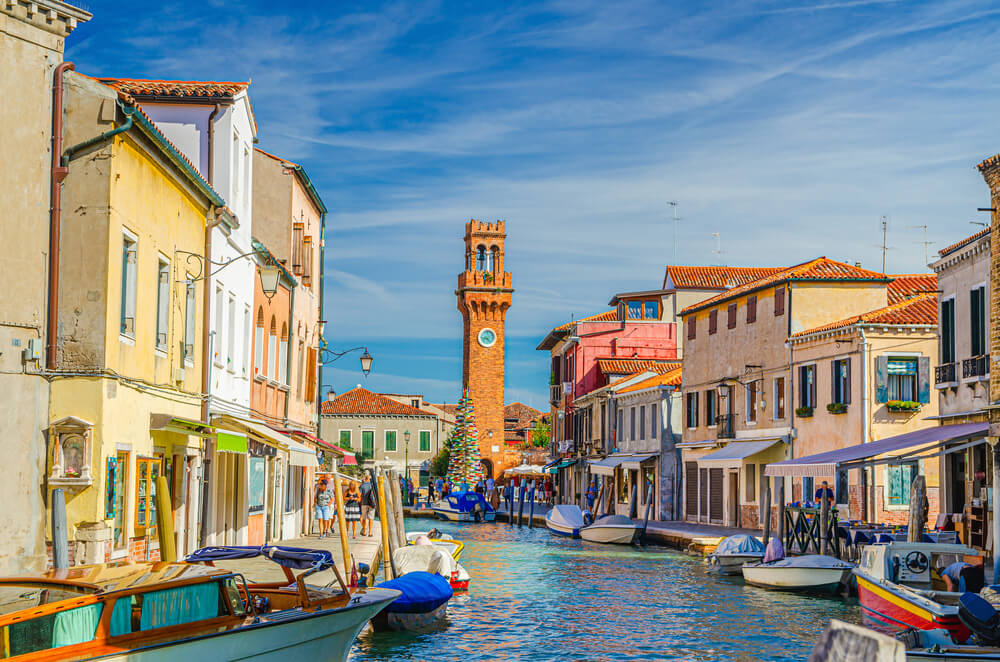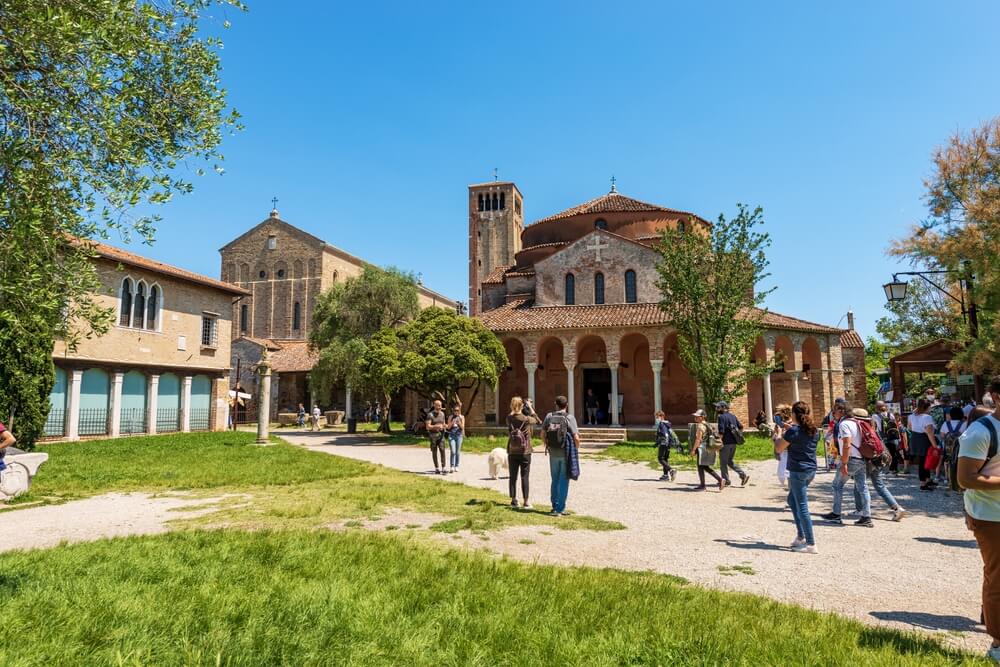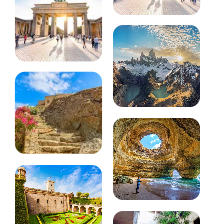Murano, Burano, Torcello: history, activities, crossing…

Do these names ring a bell? Away from the world, our surprise! These 3 Venetian islands have each acquired their own identity and reputation alongside Venice. The history, gastronomy and crafts on these islands more than make up for the few minutes’ sail to get there. A fine addition to your Italian holiday memories.
So andiamo for an escape off the beaten track!
The letter ‘O’ at the very end as a technical memo
1. First stop: Murano
One kilometre north-east of Venice, that’s how far you have to travel, or rather cross, to land on one of the lagoon’s largest islands. We’ve named it Murano! With a surface area of 1.17km², divided in two by the Grand Canal, this little corner of paradise is reminiscent of the Serenissima. Only on a smaller scale, and without all the hustle and bustle.
Forever the home of glass
Murano, Murano, Murano… The more you repeat the name, the more you’re sure you’ve heard it at least once before. The question is, why? With words like soufflage or verrerie, your cloud of confusion should normally dissipate. In fact, the island of Murano is world-famous for its production of blown glass. And more than just a major tourist attraction, this craft has made up the history and DNA of the island.
To understand how it all began, we need to go back at least 11 centuries. Back then, glassblowers set up their workshops in Venice itself. This made it easier for them to sell the fruits of their labour in the many commercial exchanges that passed through the port. The problem was that this highly profitable situation for some could no longer be sustained by others.
The ovens used by the craftsmen increasingly represented a danger to the Venetians’ wooden houses. Anxious to put an end to this general fear, the Venetian government drew up a decree in 1291 forcing glassmakers to work on the neighbouring island of Murano.
Since then, the destiny of the island and glass production have remained linked. And from generation to generation, the skills and secrets of glassmaking have been carefully handed down and preserved.
For a complete tour of the island
Given the importance of glassblowing in the life of the island, it’s natural to want to learn a little more about it. What better way to do this than to visit one or more of the glassblowers’ workshops?
By stepping over to the other side of the curtain, you’ll be able to witness the various stages of production in the art of glassblowing, from the raw raw material to the final composition. And don’t forget to set your sights on one of the unique pieces on sale in the boutique. Like a vase for your next bouquet of flowers, or the perfect jewellery set to match your latest clothing purchase.
To help you, here are some names of Murano glassworks open to visitors:
- Vetreria Artistica Colleoni
- Atelier Salvadore Murano
- Ex Chiesa Santa Chiara
- Gino Mazzucato Murano Glass
Please note : the workshops tend to open for only a few hours a day. So be sure to check the opening times in advance and, above all, reserve your place.
Before or after this first activity, you can learn more about the island of Murano by visiting or admiring some of its places of interest, such as :
- Il Museo del vetro (The Glass Museum), normally open every day from 10am to 5pm, with final admission at 4pm.
- The Basilica of Santi Maria e Donato is open to visitors from Monday to Saturday, 9am to 5pm, and on Sundays from 12pm to 3.30pm.
- The Chiesa San Pietro Martire is open to visitors from 9am to 5pm on Mondays and on Wednesdays, Thursdays and Fridays. Then from 9am to 3.30pm on Tuesdays and from 11am to 4.30pm at weekends.
- The Chiesa Santa Maria degli Angeli is open daily from 7am to 7.30pm.
- The Palazzo da Mula, now a cultural centre.
- The Murano Lighthouse, in operation since 1932.
- The “Cometa di Vetro”, a blue glass sculpture.
2. Second stop: Burano
Still to the north-east of Venice, but this time within a 7km radius, lies the beautiful island of Burano. Well… technically, it’s an archipelago of four islets (San Mauro, Giudecca, San Martino, Terranova) separated by 3 main canals: the Rio Pontinello, the Rio Giudecca and the Rio Terranova.
Unlike Murano and Torcello, which have the title of city, Burano is a simple village of barely 20 hectares where 3,000 people live year-round. On reading that, you can already imagine that the visit to the place will be a quick one. But that’s where the mistake lies! Once you’ve landed in Burano, time stands still, the charm takes hold and it’s clear that you don’t even want to leave. Here are some of the reasons why.
“Life in pink, in red, in mauve…
As we approach the shores of Burano, the main reason for our visit becomes apparent: the famous coloured houses. Without them, the island would certainly not be so famous. From canary yellow to poppy red, grass green to candy pink, the ‘pictorial’ setting here is an explosion of colour. The aim is to make it pop!
Surprising as it may seem, Burano hasn’t always had this totally mismatched but incredibly photogenic setting. It was the thick winter mist that gradually got the better of the first brushstrokes in yellow and red ochre, due to a lack of choice.
According to local legend, the initiative came from the island’s fishermen, who were having trouble spotting their home off the coast. But there are other, more traditional or wackier versions.
In any case, one thing is certain: behind this delightful cameo of colour lies a whole list of strict administrative rules, such as :
- Houses must be painted in two or three different colours
- Door and window frames have no choice but to be white
- Residents must contact the town hall if they wish to change the colour of their house
- Residents undertake to repaint their homes every year, as the tides, wind and salt quickly cause the colour to fade.
Tip: To fully appreciate the originality of this multicoloured scenography, you can visit the Tre Ponti bridge or the Piazza Baldassarre Galuppi.
As delicate as lace
Although Burano has been on the books since Roman times, it wasn’t until the sixteenth century that people really started to hear about it. The explanation? The development of lace-making on the island!
The women of Burano, who were very skilled at darning their husbands’ fishing nets, began to produce needle lace without a canvas backing. Their stitch par excellence, the “Punta in aria” or “stitch in the air”. Its main characteristic is the addition of relief and transparency to its design.
What began as an ordinary occupation became a creative art of excellence, exported throughout Europe until the 18th century. Even the greatest personalities of the time, such as Catherine de Medici, fought to have a piece of Burano lace in their wardrobe.
Burano lace’s popularity plummeted as industrial production of lace became less attractive, but cheaper and less time-consuming to make. Even the School of Lace, opened on the island in 1872 to preserve this long-standing tradition, failed to survive the competition. Fortunately, there are still lace-makers on the island today who are keeping this fine and noble craft alive.
For a complete tour of the island
As you stroll through Burano’s unique atmosphere, dictated by its colours, we recommend that you stop off at one of the following places:
- Il Museo del merletto (Lace Museum) open Tuesday to Sunday from 10am to 4pm.
- The Chiesa di San Martino (open daily from 8am to 12pm and from 3pm to 7pm), with its leaning bell tower and the Capella di Santa Barbara just next door.
- Piazza Baldassarre Galuppi, the island’s central square.
- Casa Bepi, the former home of painter Giuseppe Toselli, also known as Bepi Suà. Address: 339 via al Gottolo.
- The fish market held every morning in Piazza Fondamenta della Pescheria.
Perfect in every way, Burano’s gastronomic delights are sure to please. In the restaurant, the delicious fish or seafood dishes will delight your lunch break. Then, when it’s time for dessert or a snack, the pastries will help you fill up on sugar and butter with the two types of local biscuit. There’s a choice of round bussolai buranei and S-shaped essi, as their name suggests.
3. Third stop: Torcello
Unless you’ve had your fill of islands and sea crossings for the day, it would be a real shame not to combine a visit to Burano with one to Torcello. For one thing, the two islands are only 6 minutes apart. And secondly, the green and historic Torcello is well worth a visit, no matter what anyone says.
A strong reminder of the Venetian Republic
44 hectares in size and 20 inhabitants in total (if not fewer). On paper, Torcello is hardly impressive. However, more than a hundred years ago, the situation was quite different. So what could have happened?
Like other islands in the lagoon, Torcello was inhabited very early on for a variety of reasons (as a holiday resort for the Roman nobility, as a place of refuge during the Germanic invasions…). Between the 7th and 10th centuries, the town underwent a period of considerable political, cultural and commercial development. It was largely thanks to this that the Venetian state came into being.
All the stars of success aligned for Torcello. It had a population of 10,000, and its saltworks and attractive port on the trade routes between Eastern and Western Europe made it rapidly wealthy. In short, the lagoon was the place to be!
But… From the twelfth century onwards, Torcello the ‘overpowering’ was transformed into Torcello the ‘undesirable’. This was due to the silting up of its canals, which not only affected navigation but also spread malaria. As a result, the island’s inhabitants deserted it, political power moved to the area of the future Rialto, the stones of its monuments were reused for the development of Venice and its parish church was abolished.
For a complete tour of the island
Remote, moderately frequented and predominantly rural at first sight, Torcello still presents a few vestiges of its glorious past to those who take the trouble to come and see it. Here are just a few of the wonders you’ll come across on your tour, which we hope will capture your attention:
- The Basilica of Santa Maria dell’Assunta (the oldest building in the lagoon) and its museum, normally open every day from 10.30am to 5.30pm. Please note that admission to both attractions is subject to a charge.
- The Chiesa Santa Fosca is normally open every day from 10.30 am to 5.30 pm.
- Attila’s throne in front of the basilica. Legend has it that the marble seat was used by the Hun leader as he passed through Italy.
- Il ponte del Diavolo or “the Devil’s bridge”, a source of many legends.
Murano, Burano, Torcello, here we come!
Whether you’re interested in one of these islands or all three, the means of transport to get there will be exactly the same. By boat! By vaporetto (a kind of bus on the water) or by excursion, that’s the only choice you’ll have to make. To help you compare these 2 options before choosing just one, read on for some information that is sure to tip the balance in one direction rather than the other.
By Vaporetto
Lines concerned :
| Murano | Burano | Torcello | |
| From Piazzale Roma (bus station) or the train station | Line 3 | / | / |
| From Fondamente Nuove platform | 3 daytime lines: 4.12.13
1 night service : Laguna Nord |
Line 12 | Line 12 |
| From the San Zaccaria platform | Line 7 | Line 14 | / |
| From Lido Island | Line 18 | Line 14 | / |
| From the island of Murano | / | 1 daytime line: 12
1 night service : Laguna Nord |
Line 12
1 night service : Laguna Nord |
| From the island of Burano | 1 day line: 12
1 night service : Laguna Nord |
/ | 2 daytime routes: 9.19
1 night service : Laguna Nord |
Please note : Line 7 only operates from April to October.
Approximatejourney time depending on departure point :
First and foremost, you should know that the vaporetto service starts at 5am and finishes at 11pm. After that, only the 2 night-time lines (Murano and Laguna Nord) operate.
| Murano | Burano | Torcello | |
| From Piazzale Roma (bus station) or the train station | 20 minutes | / | / |
| From Fondamente Nuove platform | 10 minutes | 45 minutes | 40 minutes |
| From San Zaccaria quay | 40 minutes | 1h05 | 1h10 |
| From Lido Island | 16 minutes | 51 minutes | 57 minutes |
| From the island of Murano | / | 35 minutes | |
| From the island of Burano | 35 min | / | 6 minutes |
Ticket prices :
A single ticket, valid for one journey (75 minutes from the time it is stamped) costs an average of €12 each from the age of 6. But if you’re coming to Venice for several days and you’re the kind of person who gets restless, it’s more cost-effective to pay €30/person for a 24-hour ticket or €40/person for a 48-hour ticket.
Another tip: If you already know your next travel dates, at least 1 month in advance, think about booking your tickets directly online. Fares are usually discounted!
Via excursions
Taking the vaporetto to the islands of Murano, Burano and Torcello is a good way of getting into the locals’ shoes. But once you’ve made the crossing, the service ends immediately. But when travelling, some people like to go all out. Out of curiosity, perhaps, or because they don’t know when the opportunity will present itself again. If that’s you, we’ve got something for you.
From the centre of Venice, you can take an excursion to the 3 islands in the lagoon for an average of €30/adult and €20/child, for a duration of between 4 and 6 hours. Apart from clicking on the ‘book’ button online, it’s up to the service providers to organise everything. Here’s what’s usually included in the package (as an indication):
- Round trip crossing of the lagoon
- Historical explanations given by a French or multilingual guide on the chosen island(s)
- Visits to monuments or key addresses on the islands (glass-blowing workshop in Murano, lace factory in Burano, etc.)
- Free time for a little more independence
- A list of the best places to try the local specialities
Unlike the vaporetto, these excursions avoid wasting time in queues.
200 audioguided tours for cities all around the world
Download



